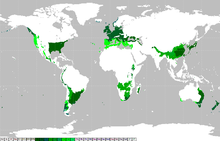This is an old revision of this page, as edited by Watchwolf49z (talk | contribs) at 18:20, 20 January 2013 (Undid revision 534021295 by 92.15.67.18 (talk)Vandals?). The present address (URL) is a permanent link to this revision, which may differ significantly from the current revision.
Revision as of 18:20, 20 January 2013 by Watchwolf49z (talk | contribs) (Undid revision 534021295 by 92.15.67.18 (talk)Vandals?)(diff) ← Previous revision | Latest revision (diff) | Newer revision → (diff) For the usage in virology, see temperateness (virology).| It has been suggested that this article be merged with Temperateness. (Discuss) Proposed since January 2013. |
| This article does not cite any sources. Please help improve this article by adding citations to reliable sources. Unsourced material may be challenged and removed. Find sources: "Temperate climate" – news · newspapers · books · scholar · JSTOR (December 2009) (Learn how and when to remove this message) |

In geography, temperate or tepid latitudes of the globe lie between the tropics and the polar regions. The changes in these regions between summer and winter are generally relatively moderate, rather than extreme hot or cold.
However, in certain areas, such as Asia and central North America, the variations between summer and winter can be extreme because these areas are far away from the sea, causing them to have a continental climate. In regions traditionally considered tropical, localities at high altitudes (e.g. parts of the Andes) may have a temperate climate.
The north temperate zone extends from the Tropic of Cancer (at about 23.5 degrees north latitude) to the Arctic Circle (at approximately 66.5 degrees north latitude). The south temperate zone extends from the Tropic of Capricorn (at approximately 23.5 degrees south latitude) to the Antarctic Circle (at approximately 66.5 degrees south latitude).
In a very broad sense, temperate climate also includes a subtropical climate, variants: subtropical semidesert/desert, humid subtropical, oceanic subtropical and Mediterranean climate. However, a typical temperate climate is one of the four climate zones in the world, beside polar regions (subarctic climate, arctic climate, tundra climate, ice cap climate) and the subtropics, tropics.
The maritime climate is affected by the oceans, which help to sustain somewhat stable temperatures throughout the year. In temperate zones the prevailing winds are from the west, thus the western edge of temperate continents most commonly experience this maritime climate. Such regions include Western Europe, and western North America at latitudes between 40° and 60° north (65°N in Europe).
Continental, semi-arid and arid are usually situated inland, with warmer summers and colder winters. Heat loss and reception are aided by extensive land mass. In North America, the Rocky Mountains act as a climate barrier to the maritime air blowing from the west, creating a semi-arid and continental climate to the east. In Europe, the maritime climate is able to stabilize inland temperature, because the major mountain range – the Alps – is oriented east-west (the area east of the long Scandinavian mountain range is an exception).
The vast majority of the world's human population resides in temperate zones, especially in the northern hemisphere because of the mass of land.
For the history of the term, see geographical zone
References
- McColl, R. W. (2005). Encyclopedia of World Geography, Volume 1. (Facts on File Library of World Geography). New York: Facts on File. p. 919.
{{cite book}}: Text "ISBN 0-816-05786-9" ignored (help) - "Solar Illumination: Seasonal and Diurnal Patterns". Encyclopedia.com. Retrieved October 4, 2012.
- "The Temperate Climate". The International Sustainability Council. 2008. Retrieved October 4, 2012.
...the north-south aligned Rocky Mountains act as a climate barrier to the mild maritime air blowing from the west.
- "Climate of Switzerland". Swiss University. Retrieved October 4, 2012.
The Alps act as a climate barrier: Southern Switzerland, which is mainly influenced by the Mediterranean Sea, is characterized by a much milder climate than Northern Switzerland.
- Brinch, Brian (2007-11-01). "How mountains influence rainfall patterns". USA Today. Tysons Corner, Virginia: Gannett. ISSN 0734-7456. Retrieved October 4, 2012.
As air ascends mountains, such as the Washington Cascades, it is forced to rise. The rising air cools, condenses, and drops rain on locations situated on the windward slopes, like Seattle. When the air descends the back side of the mountain toward Spokane, it is compressed, warming and drying it out. This sinking, dry air produces a rain shadow, or area in the lee of a mountain with less rain and cloudcover.
- Cohen, Joel E. (November 24, 1998). "Hypsographic demography: The distribution of human population by altitude". Proceedings of the National Academy of Sciences of the United States of America, Vol. 95. Washington, D.C.: The Academy. pp. 14009–14014. Retrieved September 19, 2012.
{{cite book}}: Unknown parameter|coauthor=ignored (|author=suggested) (help)
See also
| Seasons | ||
|---|---|---|
| Temperate seasons | ||
| Tropical seasons | ||
| Specific | ||
| Climate types under the Köppen climate classification | |
|---|---|
| Class A | |
| Class B | |
| Class C | |
| Class D | |
| Class E | |